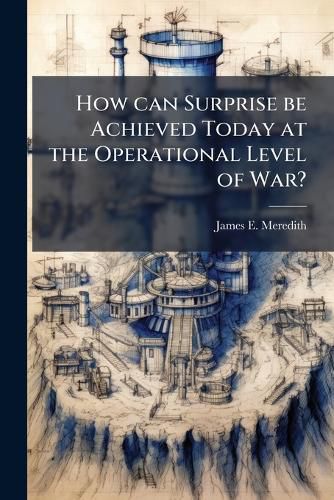Readings Newsletter
Become a Readings Member to make your shopping experience even easier.
Sign in or sign up for free!
You’re not far away from qualifying for FREE standard shipping within Australia
You’ve qualified for FREE standard shipping within Australia
The cart is loading…






This title is printed to order. This book may have been self-published. If so, we cannot guarantee the quality of the content. In the main most books will have gone through the editing process however some may not. We therefore suggest that you be aware of this before ordering this book. If in doubt check either the author or publisher’s details as we are unable to accept any returns unless they are faulty. Please contact us if you have any questions.
The primary purpose of this study is to determine how surprise can be achieved today at the operational level of war. Two supporting questions are answered as well. These are: What are the theoretical and historical foundations for the concept of surprise? And, specifically, what are the ways, means, and effects (ends) of achieving surprise at the operational level of war? The theory of surprise can be drawn from the writings of both classical and contemporary theorists. Leading military theorists who discuss the element of surprise include Sun Tzu, Carl von Clausewitz, Baron de Jomini, J.F.C. Fuller, B.H. Liddell Hart, M.M. Kiryan, V. YE. Savkin, Michael Handel and Edward Luttwak. These theorists provide assertions about the desirable effects (ends) of surprise and the various ways and means to achieve those effects. Three historical case studies of campaigns and major operations undertaken during the period 1944 to 1950 are examined for evidence of these theoretical assertions. These case studies include Cobra (1944), Manchuria (1945), and Inchon (1950).
This work has been selected by scholars as being culturally important, and is part of the knowledge base of civilization as we know it. This work was reproduced from the original artifact, and remains as true to the original work as possible. Therefore, you will see the original copyright references, library stamps (as most of these works have been housed in our most important libraries around the world), and other notations in the work.
This work is in the public domain in the United States of America, and possibly other nations. Within the United States, you may freely copy and distribute this work, as no entity (individual or corporate) has a copyright on the body of the work.
As a reproduction of a historical artifact, this work may contain missing or blurred pages, poor pictures, errant marks, etc. Scholars believe, and we concur, that this work is important enough to be preserved, reproduced, and made generally available to the public. We appreciate your support of the preservation process, and thank you for being an important part of keeping this knowledge alive and relevant.
$9.00 standard shipping within Australia
FREE standard shipping within Australia for orders over $100.00
Express & International shipping calculated at checkout
Stock availability can be subject to change without notice. We recommend calling the shop or contacting our online team to check availability of low stock items. Please see our Shopping Online page for more details.
This title is printed to order. This book may have been self-published. If so, we cannot guarantee the quality of the content. In the main most books will have gone through the editing process however some may not. We therefore suggest that you be aware of this before ordering this book. If in doubt check either the author or publisher’s details as we are unable to accept any returns unless they are faulty. Please contact us if you have any questions.
The primary purpose of this study is to determine how surprise can be achieved today at the operational level of war. Two supporting questions are answered as well. These are: What are the theoretical and historical foundations for the concept of surprise? And, specifically, what are the ways, means, and effects (ends) of achieving surprise at the operational level of war? The theory of surprise can be drawn from the writings of both classical and contemporary theorists. Leading military theorists who discuss the element of surprise include Sun Tzu, Carl von Clausewitz, Baron de Jomini, J.F.C. Fuller, B.H. Liddell Hart, M.M. Kiryan, V. YE. Savkin, Michael Handel and Edward Luttwak. These theorists provide assertions about the desirable effects (ends) of surprise and the various ways and means to achieve those effects. Three historical case studies of campaigns and major operations undertaken during the period 1944 to 1950 are examined for evidence of these theoretical assertions. These case studies include Cobra (1944), Manchuria (1945), and Inchon (1950).
This work has been selected by scholars as being culturally important, and is part of the knowledge base of civilization as we know it. This work was reproduced from the original artifact, and remains as true to the original work as possible. Therefore, you will see the original copyright references, library stamps (as most of these works have been housed in our most important libraries around the world), and other notations in the work.
This work is in the public domain in the United States of America, and possibly other nations. Within the United States, you may freely copy and distribute this work, as no entity (individual or corporate) has a copyright on the body of the work.
As a reproduction of a historical artifact, this work may contain missing or blurred pages, poor pictures, errant marks, etc. Scholars believe, and we concur, that this work is important enough to be preserved, reproduced, and made generally available to the public. We appreciate your support of the preservation process, and thank you for being an important part of keeping this knowledge alive and relevant.